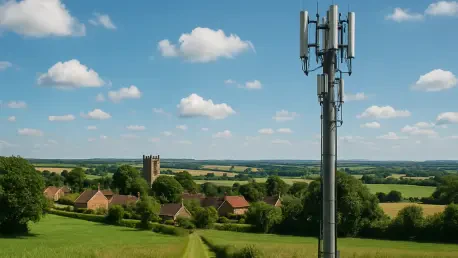In a world where digital access often dictates opportunity, millions in rural Britain have long been cut off from the connectivity that urban dwellers take for granted, grappling with mobile “not-spots” that hinder everything from business operations to emergency responses. The Shared Rural Network (SRN), a £1.3 billion initiative launched by the UK government in partnership with leading mobile operators, is changing that narrative. Targeting remote regions like the Scottish Highlands, Snowdonia, and the Yorkshire Dales, the program seeks to deliver 95% single-operator 4G coverage by the end of this year and 84% coverage from all four major providers—EE, Vodafone, Three, and VMO2—by 2027. Far more than a technical upgrade, this ambitious effort promises to reshape rural life by bridging the digital divide, fostering economic growth, and enhancing safety. As rural communities begin to experience the benefits of reliable mobile internet, the SRN stands as a testament to what targeted collaboration can achieve in addressing longstanding inequalities.
Addressing the Digital Divide
Transforming Rural Access
The core mission of the SRN is to eradicate mobile “not-spots” across rural Britain, areas where poor or nonexistent coverage has historically isolated communities from digital progress. These regions, often characterized by challenging terrain and sparse populations, have been overlooked by commercial operators due to low profitability. The program’s focus on hard-to-reach places ensures that even the most remote corners of the UK, from the windswept moors of Cumbria to the rugged landscapes of Dorset, gain access to modern connectivity. A landmark achievement came this summer with the attainment of 95% single-operator 4G coverage, driven by the upgrade of over 58 rural masts. This milestone marks a turning point for residents who can now connect reliably for the first time, fundamentally altering daily interactions and access to services that were previously out of reach due to spotty signals.
Beyond the numbers, this transformation is reshaping the lived experience of rural inhabitants in profound ways. For many, the arrival of dependable mobile internet means staying in touch with family, accessing online resources, or simply navigating daily tasks without frustration. Small villages and isolated farmsteads, once cut off from the digital world, are now integrated into a broader network of communication. This shift not only addresses a basic need but also lays the groundwork for further advancements in how rural areas function and thrive. The ripple effects of such connectivity touch on education, healthcare, and community engagement, proving that closing the digital gap is about more than just technology—it’s about equity and inclusion in an increasingly connected society.
Collaborative Innovation
The SRN’s success hinges on a pioneering public-private partnership that brings together government resources and the expertise of mobile operators like EE, Vodafone, Three, and VMO2. A key element of this collaboration is the shared infrastructure model, where upgraded masts are made accessible to multiple providers, reducing redundancy and environmental impact. This approach ensures that even areas with minimal commercial appeal receive attention, as operators work collectively rather than competitively in these regions. Government funding of £184 million has also played a critical role, particularly in converting Extended Area Service masts for multi-operator use, thereby expanding the reach of reliable 4G signals to previously neglected zones.
This innovative framework not only maximizes efficiency but also sets a precedent for how large-scale digital projects can balance cost, impact, and sustainability. By minimizing the need for duplicate structures, the SRN aligns with broader environmental goals while accelerating deployment across diverse landscapes. Challenges such as coordinating between stakeholders and ensuring equitable access persist, yet the commitment to this cooperative model remains unwavering. As the program pushes toward its next targets, the synergy between public ambition and private innovation continues to drive progress, offering a blueprint for future initiatives aimed at tackling systemic digital disparities in other parts of the UK or beyond.
Economic and Social Benefits
Boosting Rural Economies
Enhanced connectivity through the SRN is proving to be a catalyst for economic vitality in rural Britain, where businesses have long struggled with unreliable internet. Farmers, for instance, are now adopting agricultural technology to monitor crops and livestock with real-time data, improving efficiency and yields. Holiday parks in scenic destinations like Cornwall and the Lake District can manage bookings seamlessly, while tradespeople process digital payments without depending on patchy Wi-Fi. These advancements are not just conveniences; they represent a fundamental shift in how rural economies operate, enabling small enterprises to compete on a larger scale and attract more customers through digital platforms.
Tourism, a cornerstone of many rural regions, also reaps significant benefits from this digital upgrade. Visitors to picturesque areas like Devon or the Yorkshire Dales now enjoy better access to navigation tools, mobile payments, and online itineraries, enhancing their experience and encouraging longer stays or repeat visits. This, in turn, injects more revenue into local businesses such as cafes, shops, and accommodations that rely heavily on tourist spending. The economic uplift fostered by the SRN underscores a broader truth: reliable mobile coverage is not a luxury but a necessity for sustaining and growing rural livelihoods in a digital era, ensuring these communities are no longer left behind in the race for progress.
Enhancing Social Inclusion
Digital poverty, a pervasive issue disproportionately affecting rural areas, is being directly confronted by the SRN’s expansion of mobile coverage. Advocates like Elizabeth Anderson from the Digital Poverty Alliance highlight that around 19 million people across the UK face some form of digital exclusion due to inadequate access, devices, or skills. In remote regions, this isolation exacerbates disparities, cutting residents off from opportunities that urban counterparts often take for granted. By delivering reliable internet to these underserved communities, the SRN empowers individuals to engage with online platforms, from job applications to social connections, fostering a sense of inclusion in the broader digital landscape.
Moreover, the program significantly improves access to essential services that are critical for rural populations. Digital healthcare, for instance, allows patients in isolated areas to consult with doctors remotely, while online education platforms enable students to learn without the need for long commutes to physical schools. These services, which gained prominence during the COVID-19 pandemic, remain indispensable for maintaining quality of life in far-flung locations. The SRN’s impact thus extends beyond mere connectivity, acting as a bridge to equity by ensuring that geographic location no longer dictates access to vital resources or participation in the digital age.
Safety and Infrastructure Challenges
Strengthening Public Safety
One of the most immediate and life-changing impacts of the SRN lies in its enhancement of public safety across rural Britain’s most isolated areas. Emergency services, including mountain rescue teams, paramedics, and rural police forces, now benefit from faster and more reliable communication channels in regions where every second counts. In remote terrains like the Scottish Highlands or Snowdonia, where accidents or medical emergencies often occur far from immediate help, this improved connectivity can be the difference between a timely rescue and a tragic outcome. The ability to coordinate responses effectively is transforming how safety is managed in these challenging environments.
This boost to emergency capabilities also instills greater confidence among rural residents and visitors alike. Knowing that help can be summoned quickly, even in the most secluded spots, encourages outdoor activities and tourism while reducing the risks associated with isolation. For communities that have long felt vulnerable due to poor signal coverage, the SRN delivers not just a technological upgrade but a profound sense of security. The broader implications for disaster preparedness and response planning are clear, as reliable mobile networks become an integral part of safeguarding lives in areas once considered out of reach for rapid intervention.
Overcoming Implementation Hurdles
Despite its remarkable progress, the SRN faces significant obstacles in achieving its long-term goals of comprehensive coverage. Obtaining planning permissions in remote locations often proves slow and cumbersome, with local opposition occasionally arising over concerns about the visual or environmental impact of new masts. Additionally, extreme weather conditions in rugged terrains like Cumbria or the Scottish Islands can delay construction and maintenance efforts, posing logistical challenges to timely deployment. These hurdles highlight the complexity of rolling out large-scale infrastructure projects in diverse and often inhospitable landscapes.
Nevertheless, both government and industry stakeholders remain steadfast in their resolve to address these issues, with a clear target of achieving 84% multi-operator 4G coverage by 2027. Strategies to streamline approval processes and mitigate environmental concerns are being prioritized, alongside efforts to adapt deployment schedules to unpredictable weather patterns. The commitment to overcoming these barriers reflects a broader understanding that the benefits of universal connectivity far outweigh the temporary setbacks. As solutions are refined, the SRN continues to pave the way for a future where digital access is a right, not a privilege, for every corner of the UK.









